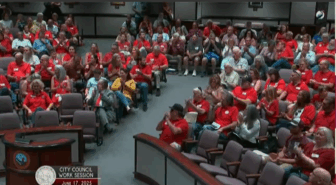Chesapeake Climate Action Network helped lead historic grassroots campaign to pressure REC Coop away from new mega-coal plant
RICHMOND, Va — In a big victory for clean energy, the CEO of Virginia’s largest electricity cooperative announced in August that energy efficiency gains – not new coal generation – would guide the cooperative’s future energy strategy in the state. This pivotal commitment from Kent Farmer, head of Rappahannock Electric Cooperative (REC), came after Virginia activists ran a multi-month campaign highlighting the dangers of investing in new coal combustion. Activists also promoted the need for increased transparency within the electric coop’s governing procedures.
Until August, the REC coop had been a vocal supporter – along with nine other electricity-selling cooperatives in Virginia — in pushing for construction of a massive new coal-fired power plant in Virginia’s Hampton Roads region just 32 miles from the Chesapeake Bay. That plant, if built, would generate 14.6 million tons of planet-warming CO2 and cost as much as $6 billion, more than any other coal plant in American history. Now, with REC’s newly articulated commitment to efficiency gains, the coal plant is not officially dead but efforts to construct it are clouded with major uncertainty. Indeed, on September 8th, the plant was officially “delayed” for 18-24 months due largely to concerns among the state’s electricity coops over inevitable carbon pollution regulations at the federal level.
In June, frustrated by the environmental and financial risks associated with the proposed Hampton Roads plant, Virginia citizens began openly protesting REC’s support. They mobilized phone banks and door-knocking campaigns across the coop region, which stretches from just north of Richmond all the way to the West Virginia border. The goal was to challenge the REC board to better serve its 150,000-plus members with energy choices that protect the Chesapeake Bay and the global atmosphere while also protecting pocketbooks.
Rob Marmet, a coop member from Marshall, Virginia, ran for the REC board of directors to bring the message directly to the coop decision-makers. Marmet ran a strong and inspiring campaign but fell short of victory, primarily owing to the board’s complicated and largely undemocratic election process.
The overall grassroots education campaign, which involved volunteers and staff from the Chesapeake Climate Action Network, reached 15,000 coop households directly with door visits and phone calls in June, July and August. Nearly a dozen letters to the editor were published in local newspapers and on one night – August 4th – over 11,000 coop members joined an historic conference call highlighting the need for better management and energy choices within the Rappahannock cooperative.
This grassroots campaign, unprecedented in size and scope in Virginia, culminated with the critically important annual meeting of the coop’s board of directors and customers in Spotsylvania, Virginia, on August 14th. At that meeting, for the first time, CEO Kent Farmer openly committed to energy efficiency improvements as the coop’s first goal before investing in any new generation options, such as the proposed Hampton Roads plant. Twelve months earlier, at the 2009 annual meeting, Farmer and other board members had stressed the need for the new coal plant without emphasizing any serious alternatives. The complete change in message clearly occurred as a direct result of the summer grassroots campaign, which was called “A Better REC.”
Over ten percent of Virginia’s total electricity sales are controlled by cooperatives like REC. Although not as large as utilities like Dominion Power, the coops play an influential role in the state power market and in markets nationwide. And, again, in Virginia, the coops have been the biggest supporters of building the disastrous new mega-coal plant in Hampton Roads.
To learn more about Marmet’s campaign and the “A Better REC” initiative, visit www. Rob4REC.com. Also visit www.chesapeakeclimate.org to learn more about CCAN’s efforts to fight coal.
###




